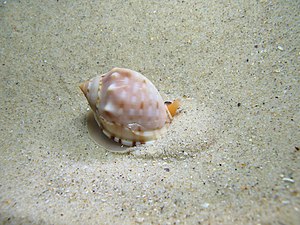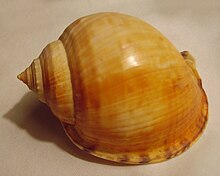Helmets
| Cassidae | ||||||||||||
|---|---|---|---|---|---|---|---|---|---|---|---|---|

A snail digs in the sand |
||||||||||||
| Systematics | ||||||||||||
|
||||||||||||
| Scientific name | ||||||||||||
| Cassidae | ||||||||||||
| Latreille , 1825 |

The helmet snails (Cassidae) are a family of marine snails that live on soft floors in shallow subtropical and tropical seas. They are predatory and eat almost exclusively echinoderms (Echinodermata).
features
The cases are right-handed and ovoid. They can be rolled up trochospirally to convolute, i.e. H. the last turns completely encompass the previous turns. The mouth can be oval, but also slot-like and extend over the entire length of the housing. The adult size ranges from about 1.7 cm to 40 cm. The foot is large and very muscular with a large propodium . In contrast to the related barrel snails (Tonnidae), the helmet snails have horny opercula . Reproductive strategies vary widely within the family. In many species a sexual dimorphism is pronounced: the females become larger than the males. The egg clutches comprise between a few hundred to several tens of thousands of egg capsules, which are deposited on a hard ground. Often the eggs are guarded by the mother. In these cases the relatively few eggs (a few hundred) are rich in yolks, and small finished animals hatch. In other cases, up to 100,000 Veliger larvae can hatch from the clutches with low- yolk eggs , which then feed on plankton.
distribution
The representatives of the Cassidae family are sometimes widespread in the tropical and subtropical seas. The species common in the Indo-Pacific include B. Cassis cornuta (Linnaeus, 1758), Cypraecassis rufa (Linnaeus, 1758), Semicassis bisulcata (Schubert & Wagner, 1829), Phalium glaucum (Linnaeus, 1758), Phalium areola (Linnaeus, 1758), Casmaria erinacea (Linnaeus, 1758 ) and Casmaria ponderosa (Gmelin, 1791). On the other hand, Cassis tuberosa (Linnaeus, 1758) and Cassis flammea (Linnaeus, 1758) play a very important role as predators of sea urchins in the western Atlantic and the Caribbean .
Way of life
Cassidae live mainly in the tidal and shallow coastal areas, but can also penetrate to a depth of around 1,100 m. They usually settle on soft substrates, but also seek out hard grounds to lay eggs. They live predatory on echinoderms such as sea cucumbers , brittle stars , starfish and sea urchins . Smaller prey, such as B. small sea cucumbers and brittle stars are devoured whole. Sea urchins and starfish are drilled and eaten or eaten in pieces.
Systematics
The family is set by Bouchet and Rocroi as a subfamily to the younger (= later established) family Tonnidae. According to the IRZN, this is not correct. Millard (1997) and Riedel (2000) therefore place them in the superfamily Cassoidea . Bouchet and Rocroi list four subfamilies within the Cassidae:
- Cassidae Latreille, 1825
- Cassinae Latreille, 1825
- (Tonninae Suter, 1913)
- Oocorythinae fisherman, 1885
- Phalinae Beu, 1981
The majority of authors regard the Tonnidae ( barrel snails ) as an independent family within the superfamily Cassoidea; therefore Bouchet and Rocroi are not followed on this point.
According to Kreipl (1997) the following breakdown results:
- Superfamily Tonnoidea
- Cassidae Swainson family, 1832
- Subfamily Cassinae Beu, 1981
- Genus Cassis Scopoli, 1777
- Subgenus Cassis s. st. Scopoli, 1777
- Cassis flammea (Linnaeus, 1758)
- Cassis madagascariensis (Lamarck, 1822)
- Cassis norai Prati Musetti, 1995
- Cassis tessellata (Gmelin, 1791)
- Cassis tuberosa (Linnaeus, 1758)
- Subgenus Hypocassis Iredale, 1927
- Cassis abbotti Bouchet, 1988
- Cassis fimbriata Quoy & Gaimard, 1833
- Cassis nana (Tenison-Woods, 1879)
- Subgenus Cassis s. st. Scopoli, 1777
- Genus Cypraecassis Stutchbury, 1837
- Subgenus Cypraecassis s. st. Stutchbury, 1837
- Cypraecassis rufa (Linnaeus, 1758)
- Cypraecassis tenuis (Wood, 1828)
- Cypraecassis testiculus (Linnaeus, 1758)
- Subgenus Levenia Gray, 1847
- Cypraecassis coarctata Sowerby, 1825
- Subgenus Cypraecassis s. st. Stutchbury, 1837
- Genus Galeodea Link, 1807
- Subgenus Galeodea s. st. Link, 1807
- Galodea echinophora (Linnaeus, 1758)
- Galodea echinophorella Habe, 1961
- Galodea ferrarioi (Bozzetti, 1989)
- Galodea hoaraui Drivas & Jay, 1989
- Galodea keyteri (Kilburn, 1975)
- Galodea maccamleyi Ponder, 1983
- Galodea rugosa (Linnaeus, 1771)
- Galodea triganceae (Dell, 1953)
- Subgenus Galeoocorys Kuroda & Habe, 1957
- Galodea leucodoma Dall, 1907
- Galodea nipponica (Sakurai & Habe, 1961)
- Subgenus Galeodea s. st. Link, 1807
- Genus Sconsia Gray, 1847
- Sconsia alexarthuri Parth, 1994
- Sconsia lindae Petuch, 1987
- Sconsia nephele Bayer, 1971
- Sconsia striata (Lamarck, 1816)
- Genus Cassis Scopoli, 1777
- Subfamily Phaliinae Beu, 1981
- Genus Phalium Link, 1807
- Phalium areola (Linnaeus, 1758)
- Phalium bandatum (Perry, 1811)
- Phalium decussatum (Linnaeus, 1758)
- Phalium fimbria (Gmelin, 1791)
- Phalium flammiferum (Röding, 1798)
- Phalium glaucum (Linnaeus, 1758)
- Phalium muangmani L. Raybaudi Massilia & Prati Musetti, 1995
- Genus Echinophoria Sacco, 1890
- Echinophoria bituberculosa (from Martens, 1901)
- Echinophoria carnosa Kuroda & Habe, 1961
- Echinophoria coronadoi (Crosse, 1867)
- Echinophoria kurodai (Abbott, 1968)
- Echinophoria oschei Mühlhäusser, 1992
- Echinophoria pilsbryi (Woodring & Olsson, 1957)
- Echinophoria wyvillei (Watson, 1886)
- Genus Casmaria H. & A. Adams, 1853
- Casmaria decipiens Kilburn, 1980
- Casmaria erinacea (Linnaeus, 1758)
- Casmaria ponderosa (Gmelin, 1791)
- Genus Semicassis Mörch, 1852
- Subgenus Semicassis s. st. Mörch, 1852
- Semicassis angasi (Iredale, 1927)
- Semicassis bisulcata (Schubert & Wagner, 1829)
- Semicassis bondarevi Mühlhaeusser & Parth, 1993
- Semicassis bulla "Kuroda" Habe, 1961
- Semicassis canaliculata (Bruguière, 1792)
- Semicassis craticulata (Euthyme, 1885)
- Semicassis faurotis (Jousseaume, 1888)
- Semicassis glabrata (Dunker, 1852)
- Semicassis granulata (Born, 1778)
- Semicassis inornata (Pilsbry, 1895)
- Semicassis labiata (Perry, 1811)
- Semicassis microstoma (from Martens, 1903)
- Semicassis pauciruge (Menke, 1843)
- Semicassis pyrum (Lamarck, 1822)
- Semicassis royana (Iredale, 1914)
- Semicassis saburon (Bruguière, 1792)
- Semicassis sophia (Brazier, 1872)
- Semicassis thomsoni (Brazier, 1875)
- Semicassis umbilicata (Pease, 1861)
- Semicassis westralis Kreipl, 1997
- Semicassis whitworthi (Abbott, 1968)
- Subgenus Antephalium Iredale, 1927
- Semicassis adcocki (Sowerby, 1896)
- Semicassis semigranosum (Lamarck, 1822)
- Semicassis sinuosum (Verco, 1904)
- Subgenus Semicassis s. st. Mörch, 1852
- Genus Oocorys fishermen, 1883
- Oocorys alcocki (EA Smith, 1906)
- Oocorys barbouri Clench & Aguayo, 1939
- Oocorys bartschi Rehder, 1943
- Oocorys cancellata (Dautzenberg & Fischer, 1897)
- Oocorys elevata Dall, 1908
- Oocorys granulosa Schepman , 1909
- Oocorys lussii Bozzetti, 1990
- Oocorys pacifica (Dall, 1896)
- Oocorys rotunda Dall, 1908
- Oocorys schepmani Turner, 1948
- Oocorys sulcata Fischer, 1883
- Oocorys weberi Schepman, 1909
- Genus Hadroocorys Quinn, 1980
- Hadroocorys dorae Kreipl & Mühlhäusser, 1996
- Hadroocorys tosaensis (Habe & Azuma, 1959)
- Hadroocorys verrilli (Dall, 1889)
- Genus Dalium Dall, 1889
- Dalium solidum Dall, 1889
- Genus Phalium Link, 1807
- Subfamily Cassinae Beu, 1981
- Cassidae Swainson family, 1832
Gofas (2011) largely follows this systematic breakdown.
Economical meaning
The meat of the great helmet snail species is eaten in many countries. The family is also very popular among snail collectors.
literature
- Philippe Bouchet & Jean-Pierre Rocroi: Part 2. Working classification of the Gastropoda . Malacologia, 47: 239-283, Ann Arbor 2005, ISSN 0076-2997 .
- Serge Gofas: Cassidae. World Register of Marine Species. http://www.marinespecies.org/aphia.php?p=taxdetails&id=22999 . Retrieved March 7, 2011.
- Kurt Kreipl: Recent Cassidae . 151 pp., Verlag Christa Hemmen, Wiesbaden 1997, ISBN 3-925919-24-4 .
- Victor Millard: Classification of the Mollusca. A Classification of World Wide Mollusca . Rhine Road, South Africa 1997, ISBN 0-620-21261-6 .
- Winston Ponder & David Lindberg: Towards a phylogeny of gastropod molluscs; an analysis using morphological characters . Zoological Journal of the Linnean Society, 119: 83-265, London 1997, ISSN 0024-4082 .
- Frank Riedel: Origin and evolution of the "higher" Caenogastropoda . Berliner Geoscientific Abhandlungen, Series E, Volume 32, Berlin 2000, 240 pages, ISBN 3-89582-077-6 .
Web links
- Heinke Schultz, Shirtingen (2005): Interactions between mollusks and sea urchins (PDF; 3.7 MB), pp. 6–8.
- Fischhaus Zepkow: Family Cassidae - Helmet snails
- Cassidae - Helmet and bonnet shells (identification key, English, on the FAO website ). From: JM Poutiers: Gastropods . In: Kent E. Carpenter, Volker H. Niem (eds.): FAO Species identification guide for fishery purposes. The living marine resources of the Western Central Pacific. Volume 1: Seaweeds, corals, bivalves and gastropods. Food and Agriculture Organization of the United Nations, Rome, 1998.
- ITIS report
- Animal Diversity Web
- National Center for Biotechnology Information
- Information system chemistry biology pharmacy of the ETH Zurich